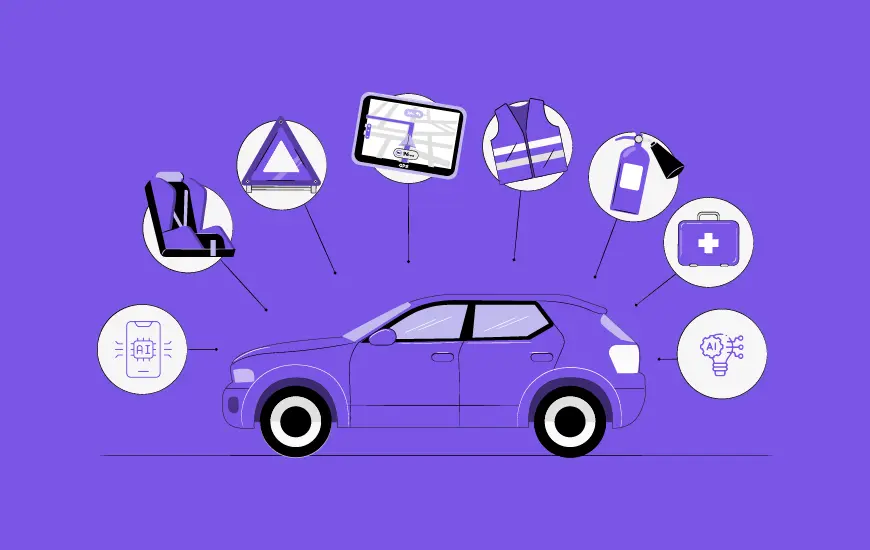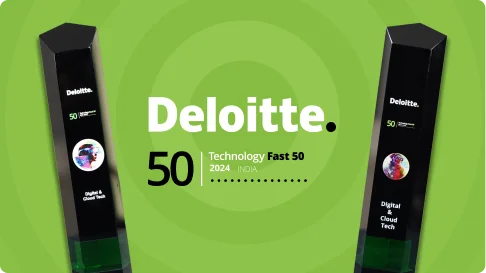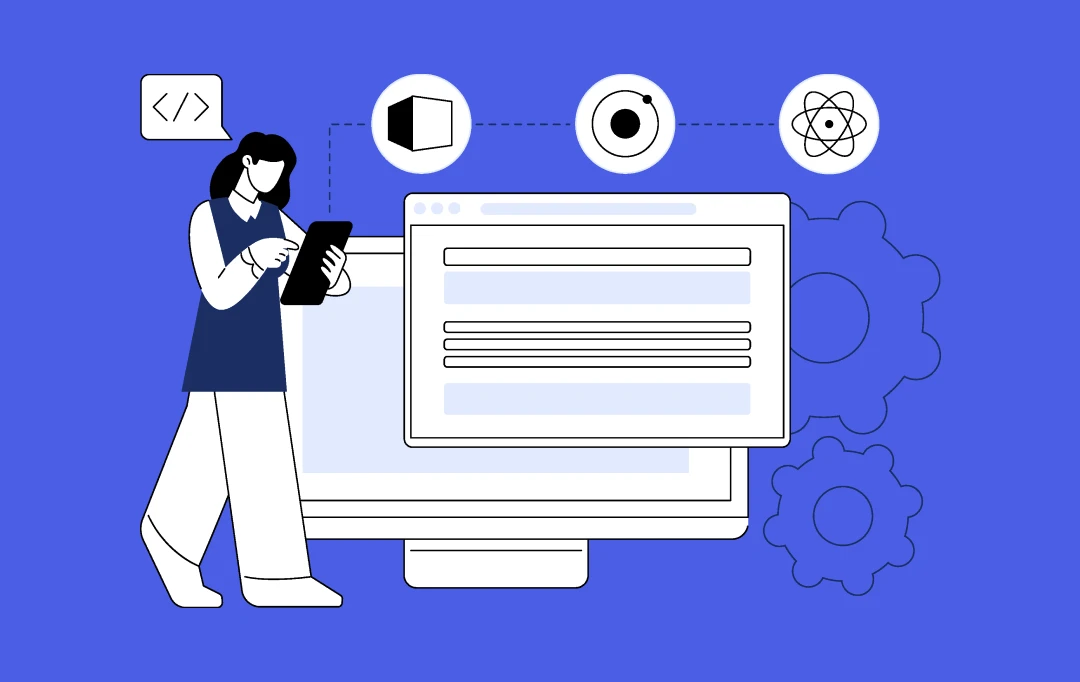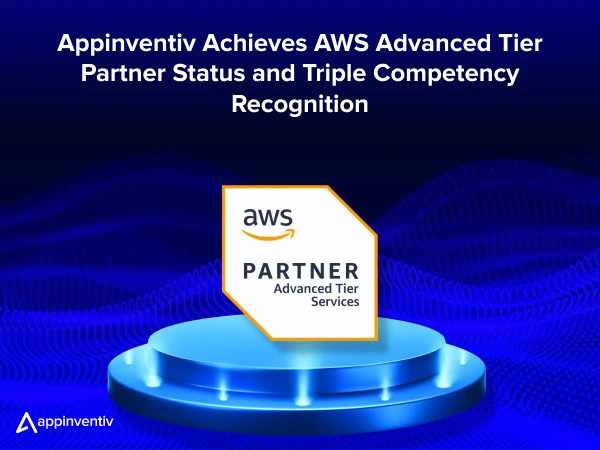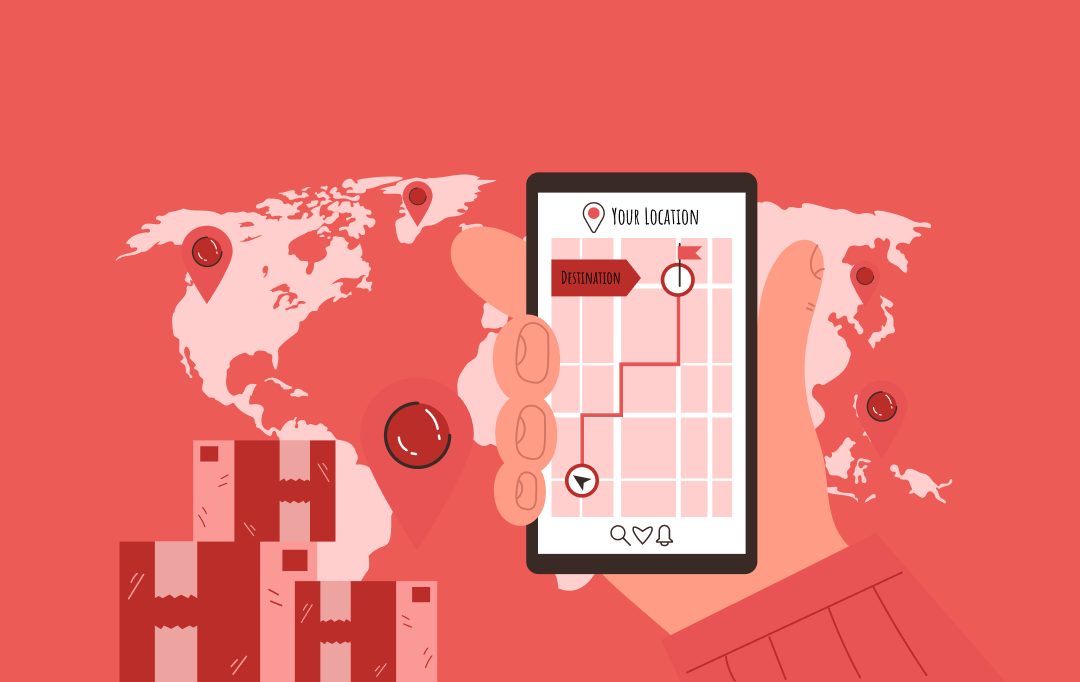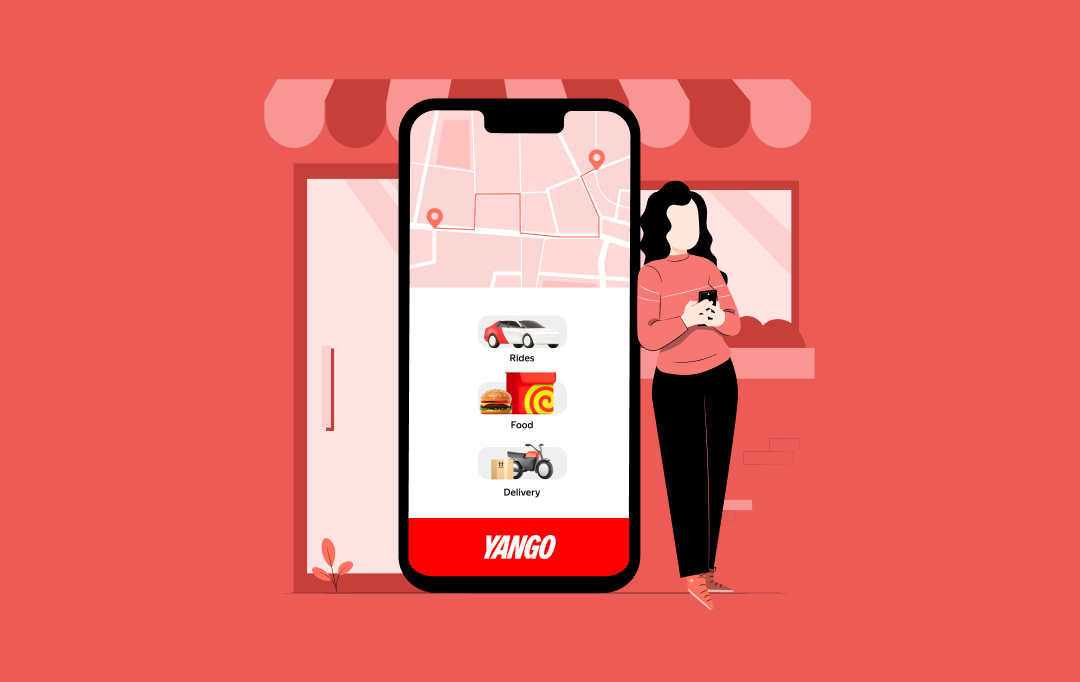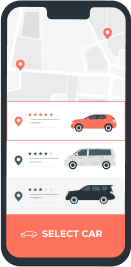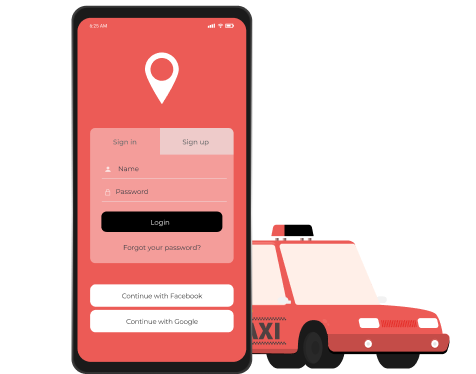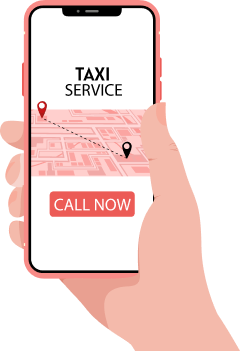- What is Dubai’s Ride-Hailing Landscape like for New Entrants?
- Yango’s Strategic Footprint in Dubai
- What are the Must-have Features to Build a Ride Hailing App Like Yango
- For Riders
- For Drivers
- For Admins
- What Design Considerations Should Businesses Prioritize?
- Localized UI for Diverse Demographics
- Simple Navigation, Fewer Taps
- Driver and Rider Modes Should Feel Unified Yet Distinct
- Microinteractions for Feedback
- Consistency Across Screens
- Dark Mode for Battery and Comfort
- Responsive Layouts for Different Devices
- Brand Identity That Stands Out
- What Tech Stack Should You Invest In?
- Frontend (Rider & Driver Apps)
- Backend (Core App Infrastructure)
- Real-Time Features
- Admin Panel (Web-Based Dashboard)
- New & Emerging Technologies
- The Step-by-Step Guide on How to Build a Ride-Hailing App
- UI/UX Design
- Backend Architecture & API Development
- Frontend Development (Rider, Driver & Admin Panels)
- Testing & Quality Assurance
- Deployment & Launch
- Post-Launch Support & Iteration
- What is the Cost of Developing an App Like Yango Ride?
- Basic App (MVP)
- Mid-Level App
- Advanced App (Full-Scale Like Yango)
- Smart Ways to Reduce Your Development Budget
- How to Gain a Competitive Edge in Dubai’s Ride-Hailing Market?
- Integrate with Public Transport & Smart City Systems
- Introduce Sustainable Fleet Options
- Build a Real-Time Incident Response Layer
- Offer Hyper-Personalized Loyalty Programs
- Enable Cross-Platform Integrations
- Tap into Voice & Multilingual UX
- Modular Pricing for Corporate and Tourist Segments
- Integrate Web3 Wallets & Loyalty NFTs
- How Can Appinventiv Help You Build an App Like Yango in Dubai?
- FAQs.
- Q. How Long Will It Take To Build A Taxi Booking App Like Yango?
- Q. How Much Will It Cost To Build A Ride Hailing App Like Yango?
- Q. What Role Does AI Play in Developing a Yango-like App?
- Q. How to build a ride-hailing app like Yango and ensure compliance with local transportation laws?
- Q. Why does the cost to develop a taxi app vary between iOS and Android?
Dubai’s streets are buzzing with innovation. The city is fast becoming a playground for smart mobility, from AI-driven traffic systems to autonomous taxis. In the middle of it all, the decision to build an app like Yango has brought serious traction, offering seamless, affordable, and tech-savvy transport alternatives.
But here’s the thing: success in this space isn’t just about building an app that connects riders to drivers. It’s about creating a platform that feels intuitive, reliable, and ready to scale in one of the most competitive tech environments in the world.
If you’re toying with how to build a ride-hailing app, whether to serve a niche, introduce a local twist, or simply rival the big players, this article is your blueprint. We’ll walk you through everything: from the core features of ride-hailing apps and backend architecture to legal requirements and scaling strategies tailored for Dubai’s and other similar areas’ unique market.
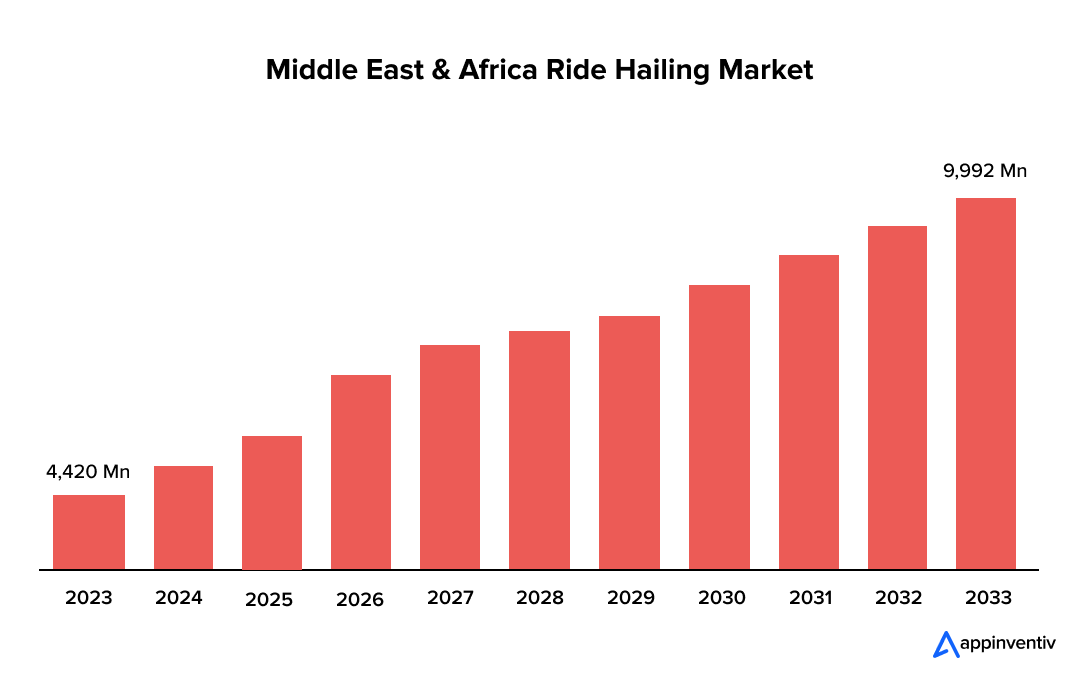
Ready to hit the road? Let’s dive in.
What is Dubai’s Ride-Hailing Landscape like for New Entrants?
Dubai’s ride-hailing market is on a fast track. Driven by rapid urban development, a tech-forward population, and an ever-growing number of tourists, the demand for smart mobility solutions is only rising. The UAE’s ride-hailing sector is expected to generate over $203 million in revenue by 2025, with a steady upward trajectory beyond that.
Dubai alone completes more than 500,000 ride-hailing trips daily, making it one of the region’s most active hubs for on-demand mobility.
While Uber and Careem have long dominated this space, newer entrants like Bolt, BluSmart, and Yango are shaking things up.
The UAE ride-hailing market is set to explode to $254.51M by 2029. Don’t just watch—build a badass custom app that outperforms Yango and owns the streets!
Yango’s Strategic Footprint in Dubai
Yango, a global ride-hailing service backed by Yandex, officially launched in Dubai in 2022. However, unlike traditional taxi apps, Yango follows a slightly different playbook. It partners with local transport providers and overlays its tech ecosystem to enhance user and driver experiences.
Its app comprises a geolocation feature that offers real-time GPS tracking, automatic route optimization, multilingual support, and in-app cashless payment—features that perfectly align with Dubai’s lifestyle expectations.
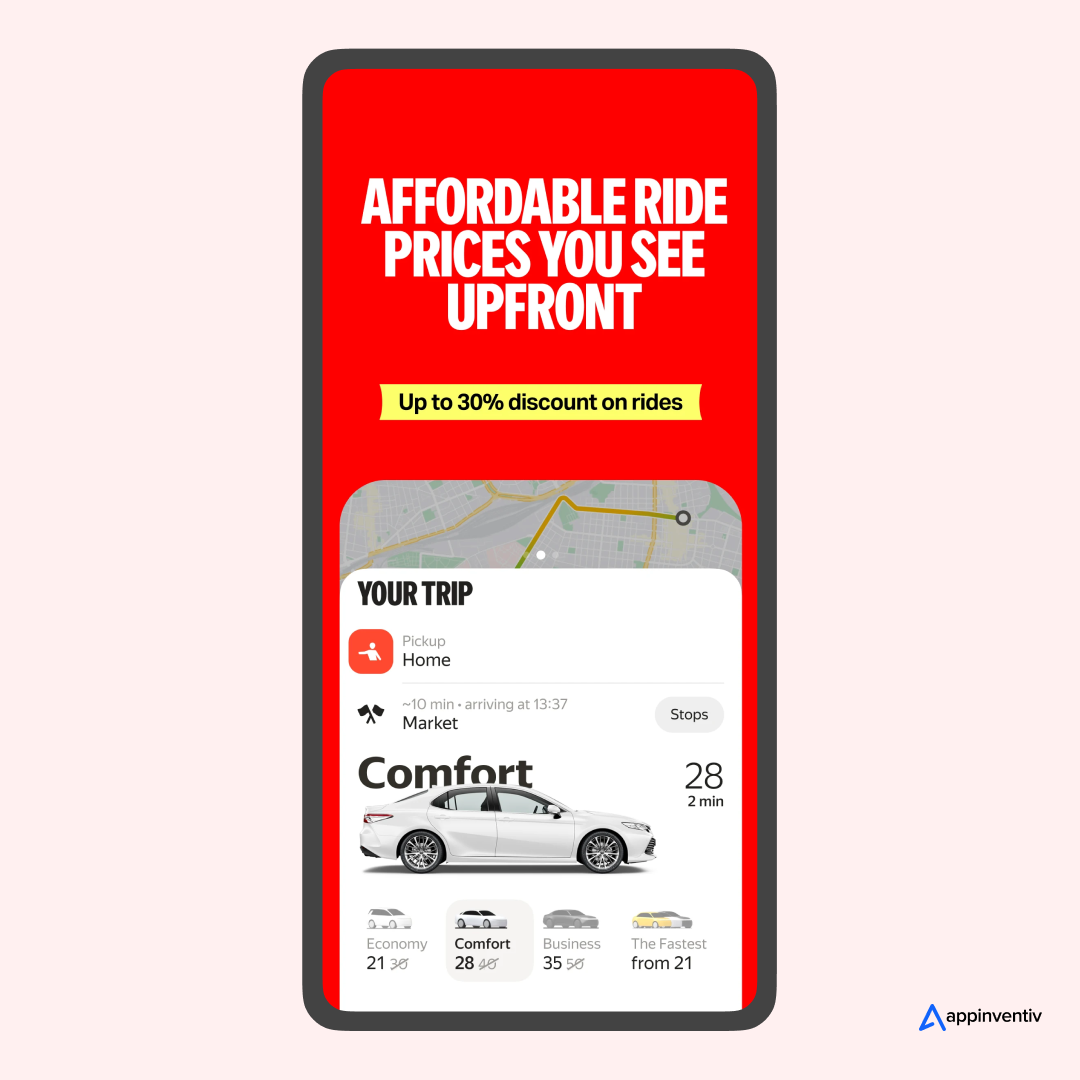
What also sets it apart and increases the intent to build a ride hailing app like Yango is its effort to position itself as a premium but accessible service. It uses algorithms to assign the closest and most suitable driver, reducing wait times and improving ride efficiency. Yango is gradually carving out a notable share of Dubai’s mobility scene with a sleek UX and an expanding local fleet.
What are the Must-have Features to Build a Ride Hailing App Like Yango
A sleek interface might attract users, but the features keep them returning. When building a ride-hailing app like Yango, you’re not just designing for one user type. You’re balancing the needs of riders, drivers, and platform admins – each with their expectations, goals, and challenges.
Let’s break down what each side of the ecosystem needs when you develop a taxi app like Yango.
For Riders
Riders in Dubai are tech-savvy and value convenience. To build loyalty and drive app usage, the efforts to develop an app like Yango ride must cover every touchpoint from booking to drop-off with precision and ease.
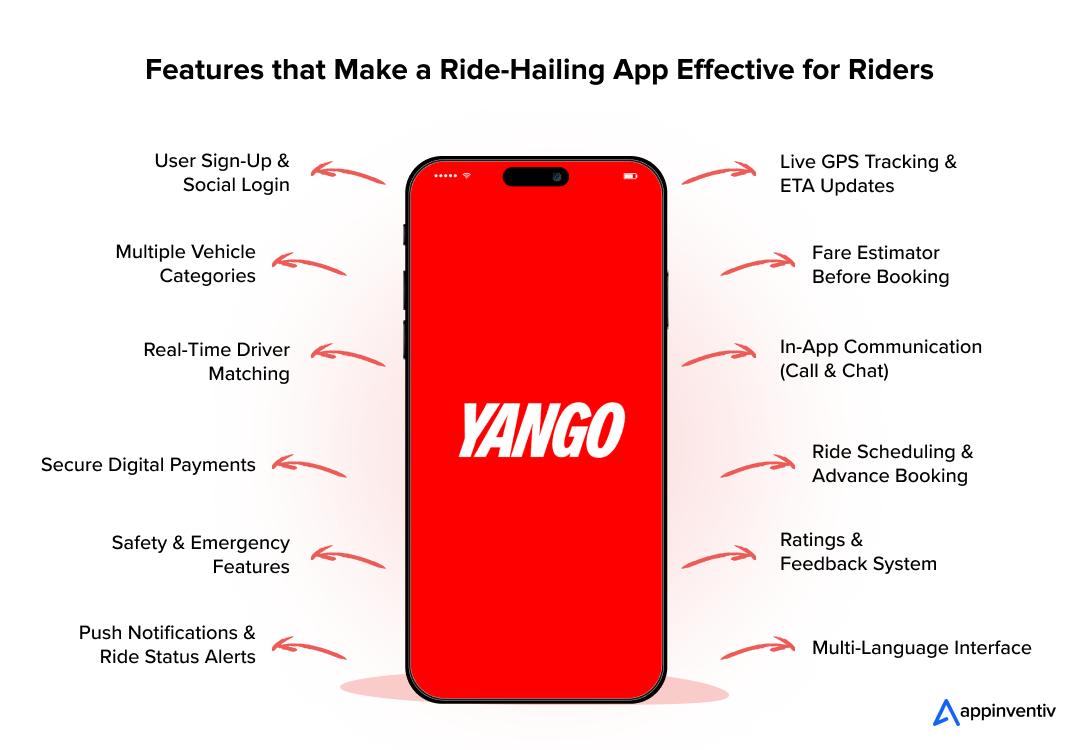
User Sign-Up & Social Login
Allow users to register quickly via email, mobile number, or social media accounts like Google and Facebook. A smooth onboarding process when you create an app like Yango Ride would boost app adoption and eliminate early friction.
Live GPS Tracking & ETA Updates
Riders should be able to view their driver’s live location on the map, along with the estimated arrival time. This would increase transparency and help reduce wait-related frustration.
Multiple Vehicle Categories
Offer flexible ride options such as Economy, Business, and XL to cater to different budgets and group sizes. This is especially relevant in Dubai, where user expectations range from affordable to premium travel.
Fare Estimator Before Booking
Enable users to calculate their trip cost upfront, based on distance, time, and traffic. Transparent pricing improves trust and sets clear expectations.
Real-Time Driver Matching
The app should instantly connect the rider to the nearest available driver, minimizing waiting time and optimizing route planning from the start.
In-App Communication (Call & Chat)
Integrate chat and call features that allow riders to contact their drivers without revealing personal numbers. This will add a layer of privacy and improve coordination.
Secure Digital Payments
Support for multiple payment options – credit/debit cards, Apple Pay, Google Pay, digital wallets, and even cash, makes the platform more accessible to all user types.
Ride Scheduling & Advance Booking
Provide the ability to book rides in advance for business meetings, airport pickups, or special events. This is one of the popular ride-hailing app features aimed at Dubai’s corporate and expat communities.
Safety & Emergency Features
Include an SOS button that connects riders to local emergency services and allows them to share live trip status with family or friends. Trust and safety should never be optional.
Ratings & Feedback System
Post-ride reviews help maintain service quality and flag issues early. Riders should be encouraged to rate the ride, cleanliness, professionalism, and comfort.
Push Notifications & Ride Status Alerts
Strategic deployment of Push notifications informs users with timely updates on driver arrival, trip start, estimated arrival time, and ride completion. This keeps engagement high and confusion low.
Multi-Language Interface
Support for Arabic and English is essential in the UAE, but offering more language options like Hindi or Urdu can further improve usability for tourists and expat users, and thus, it forms a key part of the Yango app development guide.
Bonus Read: Challenges Associated With Developing Multilingual Apps
For Drivers
Drivers aren’t just users, they’re your business partners. Giving them a reliable, fair, and empowering experience through your on-demand ride-hailing app development would help reduce churn and increase the number of quality drivers available on your platform.
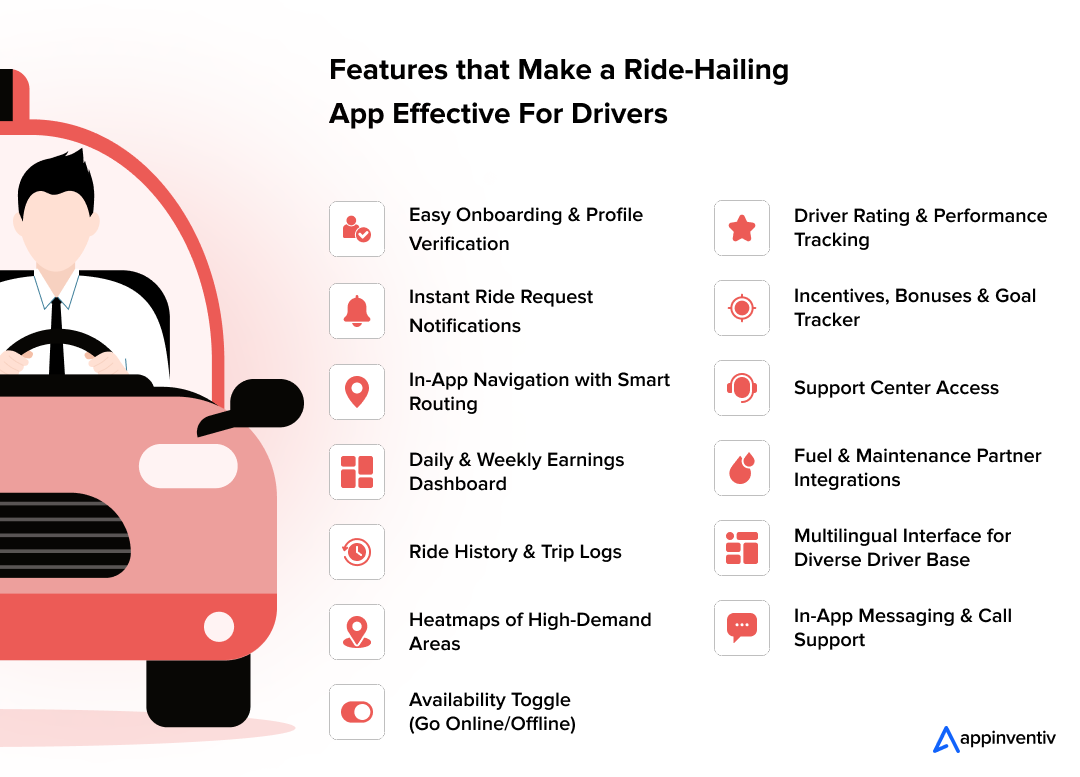
Easy Onboarding & Profile Verification
Let drivers sign up quickly using their Emirates ID, driving license, and vehicle documents. A mobile-first, step-by-step onboarding process helps speed up verification, getting drivers on the road faster. Clear instructions and real-time status updates keep the process smooth, reducing drop-offs during onboarding.
Instant Ride Request Notifications
When you build a taxi booking app like Yango, drivers should receive real-time alerts for new ride requests nearby, with detailed information about pickup location, estimated fare, and distance. The faster they can accept a ride, the smoother the user experience becomes, ensuring that riders aren’t kept waiting too long.
In-App Navigation with Smart Routing
When you create an app like Yango Ride, built-in GPS navigation with turn-by-turn directions and live traffic updates saves time and fuel. Integrating with trusted map APIs like Google Maps or TomTom ensures that routes are always accurate and reliable, even during rush hour or in areas with frequent congestion.
Daily & Weekly Earnings Dashboard
Give drivers a full breakdown of earnings, completed rides, bonuses, and pending payments. A clear, user-friendly dashboard that tracks earnings over time helps build trust and encourages consistent performance. Drivers should also be able to track their cumulative performance over weeks and months to identify patterns or opportunities for improvement.
Ride History & Trip Logs
During Yango taxi booking app development, every completed or canceled ride should be stored in the driver’s history. This includes the ride’s start and end points, duration, and fare. By keeping a detailed trip log, drivers can better manage their time, track their earnings more accurately, and review any discrepancies with the support team.
Heatmaps of High-Demand Areas
Drivers should be able to see zones with high rider demand during peak hours. These dynamic heatmaps, generated based on real-time data, show areas with surges in ride requests. By enabling this feature, drivers can position themselves in the most profitable locations, reducing idle time and boosting earnings.
Availability Toggle (Go Online/Offline)
Drivers should have the flexibility to toggle between available and unavailable status. When you build an app like Yango, these features become essential for part-time drivers or those who want to control their schedules. They help create a balanced, manageable workload and minimize stress for drivers who prefer to work at specific hours.
In-App Messaging & Call Support
Allow seamless communication between the driver and rider for better coordination through the features of ride-hailing apps. This could include options to send a quick text message or initiate a call without revealing personal phone numbers. Number masking ensures privacy for both parties, which builds trust and enhances the overall experience.
Driver Rating & Performance Tracking
Drivers should be rated after every ride. This helps maintain service quality and gives drivers insights into areas they can improve upon. A comprehensive performance tracking system will help drivers stay motivated and committed to high service standards.
Incentives, Bonuses & Goal Tracker
Keep drivers motivated with daily, weekly, or monthly bonus opportunities based on ride completion, ratings, or operational goals. When you develop a taxi app like Yango, a real-time incentive tracker would let them monitor their progress toward unlocking these bonuses. Moreover, gamification elements like goal-setting and rewards can increase driver satisfaction and retention.
Support Center Access
Offer an easy-to-use support system within the app that allows drivers to submit tickets or chat with customer service. Whether it’s an app issue or a ride-related dispute, a fast, accessible support center is critical to resolving problems promptly. Keeping drivers engaged and ensuring they feel supported strengthens the driver-partner relationship.
Fuel & Maintenance Partner Integrations
When developing a ride-hailing app in 2025, consider offering partnerships with local service providers—such as fuel stations, car service centers, and insurance companies—so drivers can benefit from discounts and rewards. These benefits help retain drivers by reducing operational costs and making the app feel like a more rewarding platform.
Multilingual Interface for Diverse Driver Base
Support for multiple languages, such as English, Arabic, Urdu, and Hindi, ensures that your driver base, whether local or expat, can use the app comfortably and efficiently. This is especially important in a cosmopolitan city like Dubai, where drivers come from various backgrounds and speak different languages.
For Admins
As the backbone of your ride-hailing app, the admin panel side of the ride-hailing app features must provide complete control over everything, from monitoring trips to managing user and driver accounts. With high transparency and functionality, your platform can run smoothly and scale.
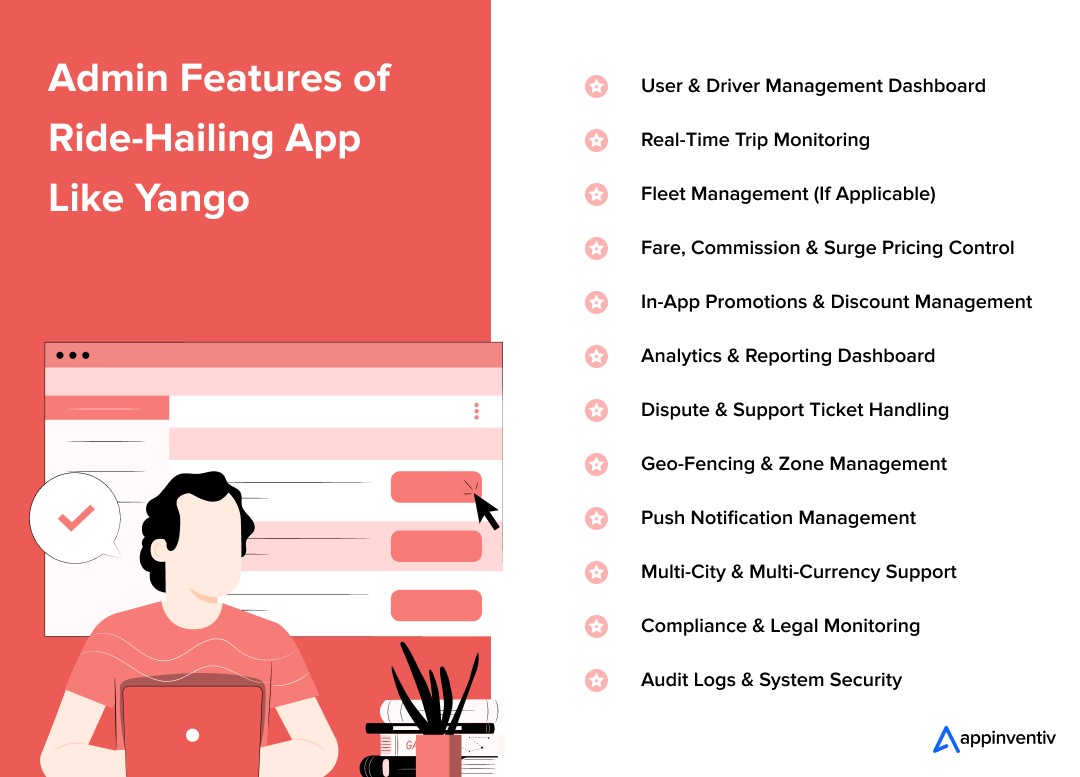
User & Driver Management Dashboard
Admins should be able to add, update, or deactivate riders and drivers in real time. With a centralized user and driver management system, you can instantly verify profiles, ensure compliance with local regulations, and address user concerns.
Real-Time Trip Monitoring
The admin panel should allow full visibility into live rides, including active trips, driver locations, and estimated arrival times. This is crucial for monitoring the quality of service and stepping in if issues arise.
Fleet Management (If Applicable)
If your service includes a fleet of vehicles, an integrated set of fleet management technologies and system-related features of ride-hailing apps can help monitor vehicle performance, maintenance schedules, and fuel consumption. This helps ensure that your fleet operates at peak efficiency.
Fare, Commission & Surge Pricing Control
Admins can adjust pricing in real-time based on demand, location, or traffic conditions. Surge pricing algorithms allow you to maximize revenue during high-demand periods while offering dynamic fare adjustments.
In-App Promotions & Discount Management
You can set up and monitor promotional campaigns, discounts, and referral programs directly from the admin panel. These can attract new riders, retain existing ones, or incentivize drivers during off-peak hours.
Analytics & Reporting Dashboard
A detailed automotive analytics panel will provide key insights on everything from trip volume and revenue to driver performance and user retention. Visual charts, graphs, and reports help decision-makers understand the business’s health at a glance.
Dispute & Support Ticket Handling
Enable admins to track customer or driver disputes, assign tickets, and resolve issues quickly. The dispute resolution system can also track complaint history, ensuring that all concerns are addressed efficiently.
Geo-Fencing & Zone Management
Admins can manage service zones by setting up geo-fencing technology. These ride-hailing app features allow you to define operational boundaries and set up pricing models based on high-demand or restricted zones like airports, popular tourist attractions, or city centers.
Push Notification Management
Send targeted, timely notifications to riders and drivers for everything from new features and promotions to service disruptions or updates. Real-time alerts will keep users engaged and informed.
Multi-City & Multi-Currency Support
As your service grows, you may expand to multiple cities or countries. The admin panel should allow easy city management and currency conversion to ensure smooth operations across different markets.
Compliance & Legal Monitoring
Ensure compliance with local laws and regulations, especially in a city like Dubai. The admin panel should have features to build a taxi booking app like Yango, such as monitoring driver background checks, insurance requirements, and vehicle documentation, reducing legal risk.
Audit Logs & System Security
Admins should have access to a complete history of app actions. Audit logs allow tracking changes to user data, payments, or settings, while robust security protocols prevent unauthorized access.
These Yango app features give admins full visibility and control over the operation, making it easier to scale, monitor, and improve the service as it grows.
What Design Considerations Should Businesses Prioritize?
In Dubai’s fast-paced, visually elevated app market, design isn’t just about aesthetics, clarity, culture, and conversion. A well-designed ride-hailing app guides users intuitively, encourages repeat use, and builds trust from the first tap—all this while impacting the ride-hailing app development cost.
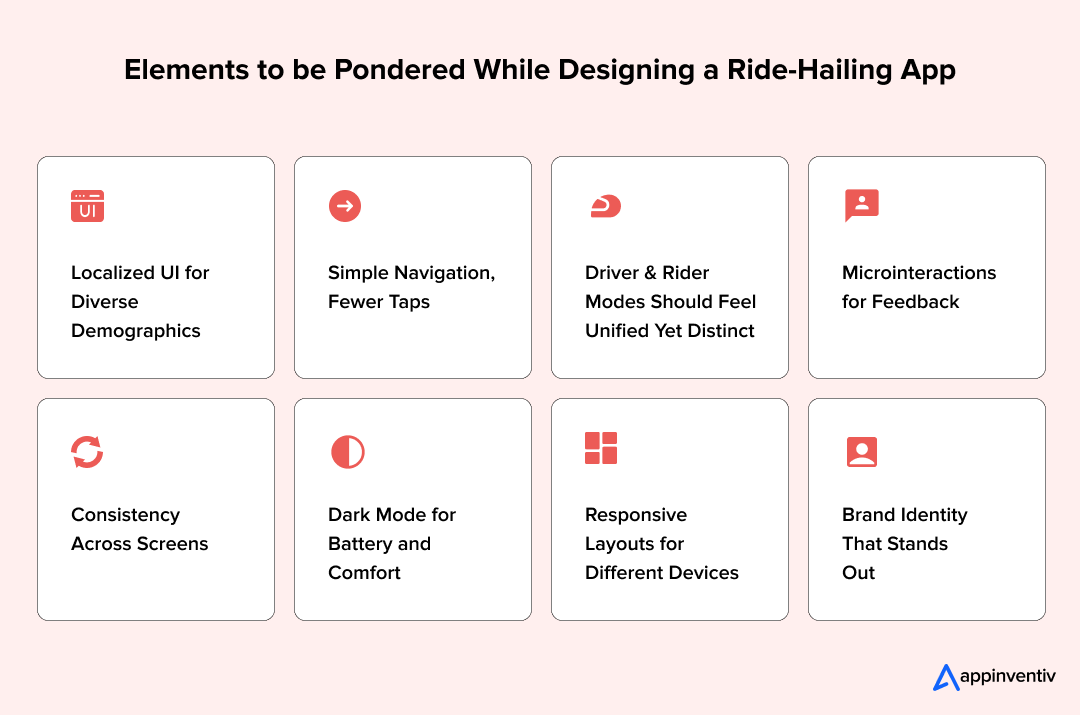
Localized UI for Diverse Demographics
Design with Dubai’s multilingual, multicultural population in mind. Use clear iconography, right-to-left language support (especially Arabic), and localized color schemes that resonate with expats and local users. Ultimately, your app should feel instantly familiar, no matter who’s using it.
Simple Navigation, Fewer Taps
Users shouldn’t have to think twice. Whether they’re booking a ride or managing trip history, design every screen to minimize cognitive load. Fewer steps to complete a task = higher satisfaction and better retention.
Driver and Rider Modes Should Feel Unified Yet Distinct
While both user types interact with the same ecosystem, their goals differ. Use color coding, layout variations, and tailored dashboards to ensure each interface feels purpose-built, yet still part of the same brand family.
Microinteractions for Feedback
Subtle animations, loading indicators, swipe actions, and button presses make the app feel alive and responsive. These microinteractions, while impacting the cost of developing an app like Yango ride, help guide the user and confirm that the system is working, especially important during bookings or cancellations.
Consistency Across Screens
Typography, padding, buttons, and icons should follow a clear design system. Consistency makes the app easier to navigate, more intuitive, and visually polished. Focusing on it when you develop an app like Yango ride also speeds up future feature rollouts without disrupting the experience.
Dark Mode for Battery and Comfort
Adding a dark theme isn’t just trendy – it improves legibility at night (ideal for drivers) and saves battery life on OLED screens. Let users toggle between modes based on preference or time of day.
Responsive Layouts for Different Devices
Your UI should scale gracefully from iPhones to Androids, tablets to rugged driver devices. Designing responsively ensures that no matter where the app is opened, it always looks clean and functions properly.
Brand Identity That Stands Out
Use a distinct color palette, consistent fonts, and icon styles that reflect your brand’s voice. The goal? Develop a taxi app like Yango that makes \it instantly recognizable on the user’s home screen – and make every screen feel like it belongs to the same ecosystem.
Our elite mobile app development crew will morph your plain app into a jaw-dropping beast with our custom solutions.
What Tech Stack Should You Invest In?
Choosing the right tech stack isn’t just about what works – it’s about what performs at scale, integrates easily, the efforts for how to build a ride-hailing app, and what would keep you ahead of the curve. Dubai’s ride-hailing market demands speed, security, and real-time intelligence – and your stack should deliver all three.
Frontend (Rider & Driver Apps)
- Frameworks: Flutter or React Native
- Languages: Dart (Flutter), JavaScript/TypeScript (React Native)
- Mapping APIs: Google Maps SDK or Mapbox
- UI Libraries: NativeBase, React
Backend (Core App Infrastructure)
- Frameworks: Node.js or Django
- Languages: JavaScript, Python
- Databases: PostgreSQL or MongoDB
- Authentication: Firebase Auth, OAuth 2.0, JWT
- Push Notifications: Firebase Cloud Messaging or OneSignal
Real-Time Features
- Sockets: Socket.IO or MQTT
- Live Location Tracking: Firebase Realtime Database or PubNub for smooth location updates
- Geofencing: Google Maps Geofencing APIs to trigger events like driver arrival or pickup area alerts
Admin Panel (Web-Based Dashboard)
- Frameworks: React.js or Angular
- Backend Integration: RESTful APIs or GraphQL
- Analytics & Reporting Tools: Chart.js, D3.js, or third-party integrations with Power BI or Google Data Studio
New & Emerging Technologies
- AI/ML for Dynamic Pricing & ETA Prediction:
Integrate AI in ride-hailing apps like Yango with TensorFlow or AWS SageMaker to adjust real-time fares based on demand or traffic. - Blockchain for Payment Transparency & Driver Ratings:
Use smart contracts to ensure payouts and tamper-proof records for reviews and disputes. - Computer Vision for Vehicle Verification:
Use OpenCV or Amazon Rekognition to scan license plates or detect driver faces during login. - Voice Search and Booking:
Integrate Google Assistant SDK or Alexa APIs to allow hands-free bookings. - Edge Computing for Latency Reduction:
Especially useful for handling location data faster, using solutions like Cloudflare Workers or AWS Greengrass. - AR for Pickup Point Visualization:
Help riders spot their driver more easily with AR overlays, using ARKit (iOS) or ARCore (Android).
The Step-by-Step Guide on How to Build a Ride-Hailing App
Every successful ride-hailing platform starts with a clear roadmap. The steps of how to build a ride-hailing app start from idea to app store, each phase shapes your app’s performance, experience, and total cost of developing an app like Yango Ride. Here’s how it typically unfolds:
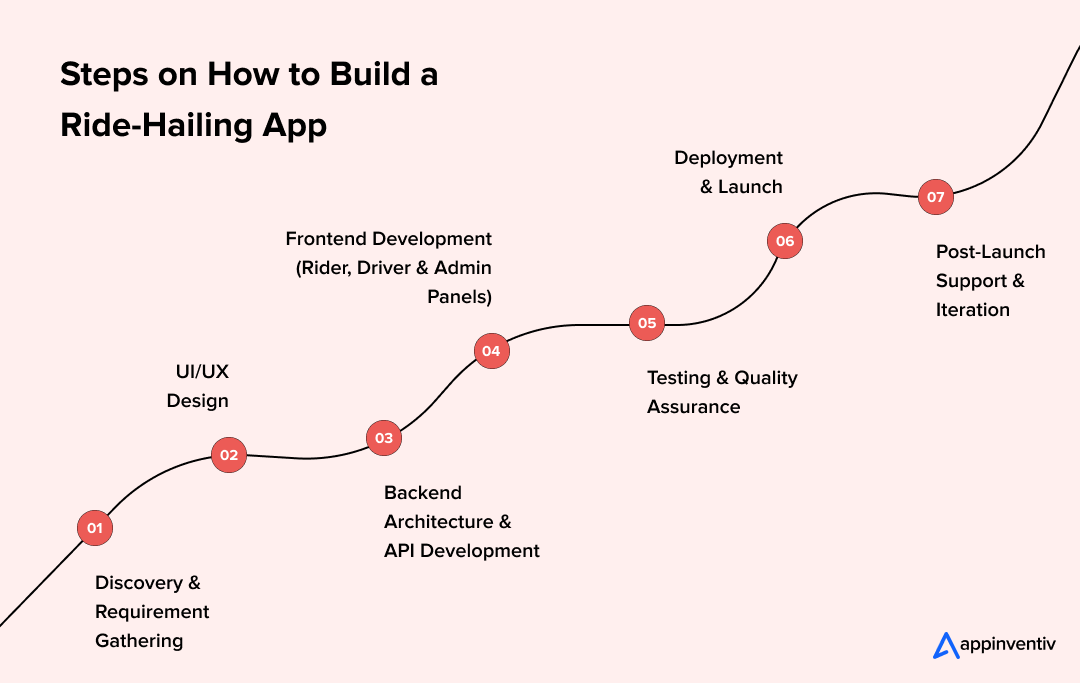 Discovery & Requirement Gathering
Discovery & Requirement Gathering
In this phase, we define the project scope, map out user journeys, identify core features, and choose the right tech stack. It’s also when the cost estimation is refined and timelines are finalized.
Estimated cost: AED 10,000 – AED 20,000
Well-planned discovery helps avoid scope creep, budget overruns, and unclear expectations later.
UI/UX Design
The next part of the process of developing an app like Yango Ride is where designers create user flows, screen wireframes, and high-fidelity mockups for the rider, driver, and admin interfaces. The goal is to offer a seamless, brand-consistent experience across all devices.
Estimated cost: AED 15,000 – AED 30,000
Polished UI/UX often becomes a competitive advantage in saturated markets like Dubai.
Backend Architecture & API Development
This includes setting up the server environment, database schema, and APIs for core modules like booking, fare calculation, trip tracking, and notifications.
Estimated cost: AED 40,000 – AED 80,000
The more complex your backend logic and integrations (e.g., multi-currency, dynamic pricing), the higher this cost.
Frontend Development (Rider, Driver & Admin Panels)
The Yango-like app development steps also include a stage where developers build the app interfaces for iOS, Android, and the web-based admin portal. This phase is about transforming designs into a functional product.
Estimated cost: AED 60,000 – AED 120,000
The number of user roles and advanced features (like route optimization or referral programs) influence pricing.
Testing & Quality Assurance
The app is tested for bugs, crashes, performance bottlenecks, and device compatibility. This includes manual testing, automation scripts, and real-time simulations.
Estimated cost to develop an app like Yango ride: AED 10,000 – AED 25,000
Cutting corners here risks costly bug fixes post-launch, especially when handling live rides or payments.
Deployment & Launch
This part of the process of developing an app like Yango Ride covers app store submissions, server deployment, DNS configuration, and analytics integration. Cloud services are configured to handle scalability and security.
Estimated cost to build an app like Yango rides: AED 8,000 – AED 15,000
Dubai-based apps must also meet local compliance and payment gateway standards, which may slightly raise deployment efforts.
Post-Launch Support & Iteration
After launch, maintenance kicks in—fixes, system monitoring, feature rollouts, and scaling based on user demand. This stage ensures long-term app health and user satisfaction while continuing to impact Yango ride clone development cost.
Estimated monthly ride-hailing app development cost: AED 5,000 – AED 12,000
Most ride-hailing platforms allocate 10–15% of their initial development cost annually for maintenance and improvements.
Now that we have examined the multiple facets deciding the factors influencing the cost of developing a ride-hailing app like Yango, let’s examine the actual cost range.
What is the Cost of Developing an App Like Yango Ride?
The cost to develop an app like Yango ride in Dubai varies depending on what you’re building – a lean MVP or a full-scale Yango-style platform with enterprise features. The local talent pool, compliance factors, and tech complexity all influence the final price. Here’s a closer look:
Basic App (MVP)
Ideal for: Startups exploring market fit
Features include: Rider and driver registration, trip requests, live GPS tracking, basic fare estimates, and secure payment gateway integration.
Estimated cost: AED 120,000 – AED 180,000
This version covers the essentials – enough to launch, gather feedback, and test core functionalities with a limited user base.
Mid-Level App
Ideal for: Growing businesses looking to scale
Features include: All MVP features + driver ratings, route optimization, promo codes, in-app support, trip history, and a functional admin dashboard
Estimated cost: AED 200,000 – AED 300,000
This tier offers more control, user engagement, and data visibility, ideal for regional operators or startups securing seed funding.
Advanced App (Full-Scale Like Yango)
Ideal for: Enterprise-grade operations or VC-funded ventures
Features include: Surge pricing, advanced route intelligence, driver behavior analytics, multilingual UX, wallet integrations, loyalty programs, heat maps, and IoT support for fleet tracking.
Estimated cost: AED 350,000 – AED 600,000+
These apps are built for scale, handling thousands of concurrent users with real-time decision engines, automation, and rich data analytics.
Smart Ways to Reduce Your Development Budget
Even if you’re eyeing a feature-rich app, there are practical ways to control Yango ride clone development cost without compromising on quality or vision:
- Start lean, grow fast: Launching with an MVP reduces upfront costs and gives you user-driven insights for future builds.
- Opt for cross-platform development: Using Flutter or React Native helps cut time and cost compared to building separate iOS and Android apps.
- Integrate third-party APIs: Instead of building them in-house, tap into battle-tested tools for maps (Google Maps, Mapbox), payment (Stripe, PayTabs), and SMS (Twilio).
- Work in phases: Prioritize features by user impact and rollout advanced capabilities post-launch.
- Choose a hybrid team model: Mix local project management with offshore development talent to balance quality and pricing.
Also Explore: Detailed cost breakdown to build Taxi booking app like Hala Taxi
How to Gain a Competitive Edge in Dubai’s Ride-Hailing Market?
Dubai’s ride-hailing sector is saturated with players like Careem, Uber, and Yango. To stand out, you need more than just functional features – innovative, local-first thinking. Here’s how to gain real traction in this competitive space after you build an app like Yango:
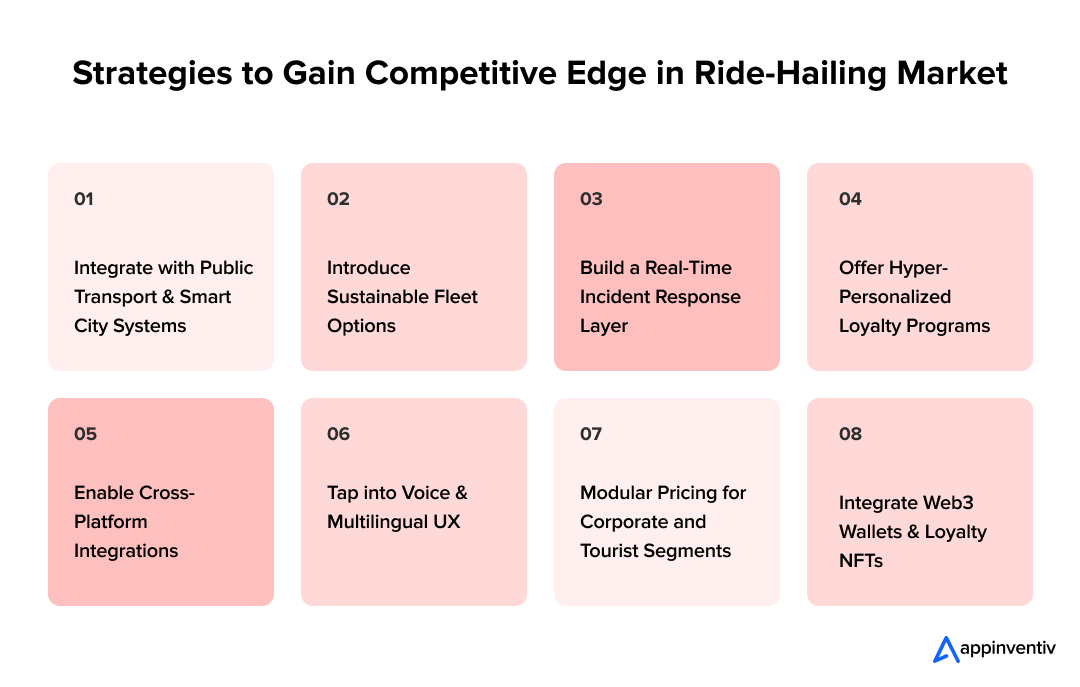
Integrate with Public Transport & Smart City Systems
Offer users a unified experience by connecting your app with RTA metro cards, public bus schedules, and smart city infrastructure. Seamless trip chaining (e.g., metro to ride-hail) can make your app the most practical option for daily commuters and tourists.
Introduce Sustainable Fleet Options
Encourage or partner with drivers who use electric or hybrid vehicles. Provide green badges, reduced commissions, or exclusive ride categories like “Eco Luxe.” Dubai’s Green Mobility Strategy 2030 is already promoting this – aligning your app with it can win users and regulators.
Build a Real-Time Incident Response Layer
Safety is a selling point when you have to answer how to build a ride-hailing app. Integrate your app with local law enforcement or private emergency response APIs to support live assistance during rides. Think: AI-based monitoring for erratic driving, rider distress signals, or immediate 2-way audio/video help.
Offer Hyper-Personalized Loyalty Programs
Use behavioral analytics to reward frequent riders with points, badges, or real-world perks, like discounts at nearby cafes or airport lounges. Localized gamification builds stickiness, especially in Dubai’s high-spending, experience-seeking demographic.
Enable Cross-Platform Integrations
Let users book rides directly through other apps like hotel apps, airline apps (e.g., Emirates or flydubai), or even delivery services. This ecosystem thinking can create multiple entry points for your app without adding friction.
Tap into Voice & Multilingual UX
With a multicultural user base, Dubai needs ride-hailing apps to work for everyone. Support voice commands in English, Arabic, Hindi, and Urdu. Also consider in-app language toggles, especially for onboarding and customer support workflows.
Modular Pricing for Corporate and Tourist Segments
Instead of flat fare models, provide adjustable pricing modules for enterprise clients, tour operators, or shopping malls. Think “Ride & Shop” bundles with Dubai Mall or “Airport Transfer + Hotel Check-In” packages.
Integrate Web3 Wallets & Loyalty NFTs
Cater to Dubai’s crypto-forward community by enabling Web3 wallets for fare payments or issuing branded loyalty NFTs. Riders could earn perks through NFTs or stake tokens for discounted monthly plans. This could position your efforts to build an app like Yango as truly next-gen.
Gaining a foothold in Dubai’s ride-hailing market isn’t just about competing on price – it’s about building relevance, local trust, and future-ready innovation. The winners will be those who don’t just move people, but move with the city’s vision.
Book your quote with our app dev experts for a custom quote and get the straight-up cost breakdown.
How Can Appinventiv Help You Build an App Like Yango in Dubai?
Appinventiv – a trusted mobile app development company in UAE brings deep technical expertise and on-ground insight to help you build a ride-hailing app that’s functional, future-ready, and Dubai-specific. Whether you envision a luxury fleet tailored to tourists or a budget-focused service for daily commuters, our teams understand the operational, cultural, and tech layers involved in launching such platforms.
Our experience with mobility solutions ensures you’re not reinventing the wheel. We’ve built ride-hailing components like real-time tracking, dynamic pricing, driver management, and smart dispatch systems already being used by global platforms. This means faster time-to-market, lower risk, and a more refined product.
What sets us apart is our ability to adapt to local nuances. From aligning with Dubai’s RTA regulations to designing culturally relevant user interfaces and multilingual flows, we ensure your product feels at home in the city. We also integrate next-gen technologies like AI, IoT, and blockchain to futureproof your platform, enabling smart fleet management or offering Web3 loyalty features.
Beyond development, we’re there for the long run. From early planning and MVP development to post-launch maintenance and scaling, we offer a full-spectrum approach. Our mobile app development company in Abu Dhabi follows an agile process that keeps you in the loop at every phase, and our transparent cost estimations ensure you’re never caught off guard.
With Appinventiv, you’re not just hiring a development team. You’re gaining a product partner who understands how to build, scale, and localize ride-hailing tech for one of the world’s most dynamic cities.
FAQs.
Q. How Long Will It Take To Build A Taxi Booking App Like Yango?
A. The timeline part of how to build a ride-hailing app like Yango app depends on its complexity, features, and your specific business goals. A basic MVP with core rider and driver functionalities can take 4 to 6 months. If you’re aiming for a feature-rich version with real-time analytics, AI-powered suggestions, and advanced fleet management, it could take 8 to 12 months or more. Timelines may vary based on team size, tech stack, and whether development is done in-house or outsourced.
Q. How Much Will It Cost To Build A Ride Hailing App Like Yango?
A. The ride-hailing app development cost Dubai typically ranges from AED 200,000 to AED 900,000, depending on the app’s complexity, feature list, tech stack, and scalability requirements. A basic MVP might sit on the lower end of the range, while a high-performance, multi-platform app with real-time maps, payment integrations, and admin panels will lean toward the higher end. Costs can also increase with AI integrations, multi-language support, or third-party APIs.
Q. What Role Does AI Play in Developing a Yango-like App?
A. AI plays a crucial role in making the efforts to build a ride hailing app like Yango smarter and more efficient. It enables real-time route optimization, dynamic pricing based on demand, fraud detection, predictive vehicle maintenance, and even customer sentiment analysis through chatbots. AI also personalizes user experiences – suggesting pick-up points, showing relevant offers, and learning from behavior patterns to improve retention. In a competitive market like Dubai, AI isn’t just an enhancement – it’s a differentiator.
Q. How to build a ride-hailing app like Yango and ensure compliance with local transportation laws?
A. When learning how to build a ride-hailing app, it’s crucial to research and comply with regional transportation laws. Start by registering your app-based business and obtaining the necessary licenses or permits. Your app should include features for driver background checks, insurance validation, and compliance with local fare regulations. Integrating features like trip logs, digital receipts, and safety buttons can also help meet legal standards and boost user trust.
Q. Why does the cost to develop a taxi app vary between iOS and Android?
A. The cost to develop a taxi app varies between iOS and Android due to differences in development tools, testing requirements, and platform-specific design guidelines. Android apps may require more testing for device fragmentation, while iOS apps need adherence to strict App Store guidelines. Developing for both platforms can increase costs by 50–100% compared to a single platform.


- In just 2 mins you will get a response
- Your idea is 100% protected by our Non Disclosure Agreement.

How Much Does It Cost to Build a Ticket Booking App like Ticketmaster?
Key takeaways: You'll need anywhere from $40,000 for a basic MVP to over $400,000 for an enterprise-grade solution if you're looking to build an app like Ticketmaster. Want interactive seat maps? Maybe AI recommendations? These features are great, but they'll definitely push your costs up. Here's where you can save some money. Asian developers charge…

Unlocking the Cost of Building a Community Platform Like Qatar Living: What to Expect
Key takeaways: Building a community platform is a business decision first and a technology project second. A strong MVP in Qatar typically starts around QAR 109,200–QAR 254,800, while full-scale platforms move into the QAR 2,184,000+ range based on scale and ambition. Success comes from solving daily user problems, not from copying features. Cost is driven…

How to Build a Taxi Booking App in Australia: Process, Features, and Costs
Key takeaways: Australia’s shift toward app-based transport is growing fast, making this the right time for businesses to build scalable taxi booking platforms. A successful taxi app in Australia depends on strong compliance, real-time accuracy, and a modular backend that supports multi-city operations. Payments, GST-ready pricing, safety workflows, and state-wise licensing must be built into…








